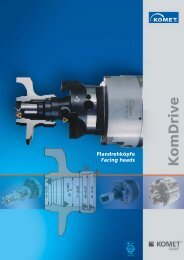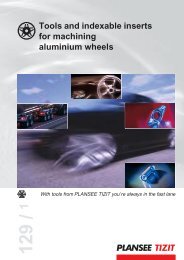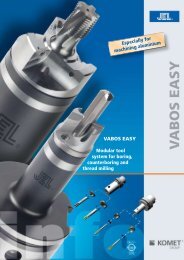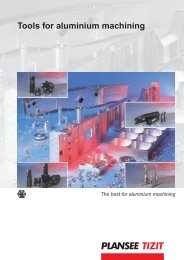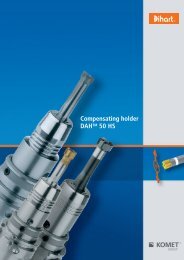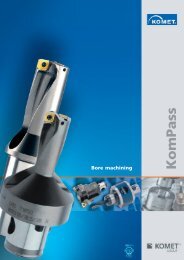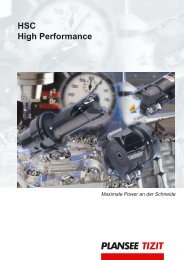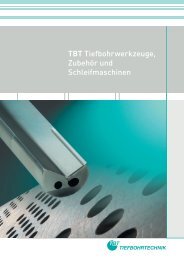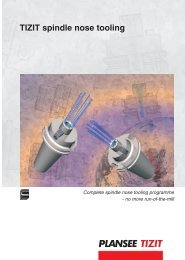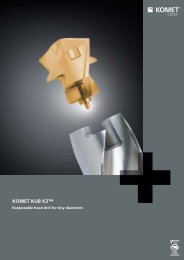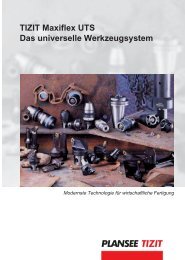KOMET KUB PentronTM - Solid drilling to 5xD - Power-Tools
KOMET KUB PentronTM - Solid drilling to 5xD - Power-Tools
KOMET KUB PentronTM - Solid drilling to 5xD - Power-Tools
Create successful ePaper yourself
Turn your PDF publications into a flip-book with our unique Google optimized e-Paper software.
<strong>KOMET</strong> <strong>KUB</strong> PentronTechnical Notes1.Starting on uneven surfaces (cast surfaces)- when inserting and withdrawing the drill, reduce the feed rate by approx. 30-50% (depending on componentstability, clamping and surface quality)2.Starting on angled surfaces / angled bore exit- when inserting the drill, reduce the feed rate by approx. 30-60% until full diameter is reached- when withdrawing the drill after interruption <strong>to</strong> the cut, reduce the feed rate by approx. 30-60%- use <strong>to</strong>ugh insert and stable corner radius3.Starting on cambered surfaces- when inserting the drill, reduce the feed rate by approx. 30-60% until full diameter is reached- when withdrawing the drill after interruption <strong>to</strong> the cut, reduce the feed rate by approx. 30-60% (dependingon component stability and clamping).4.Drilling through a cross bore- when inserting and withdrawing the drill, reduce the feed rate by approx. 30-50% (depending on componentstability, clamping and surface quality)- in the vicinity of the cross bore, reduce the feed rate by 50%- watch for chip jamming around <strong>to</strong>ol- use <strong>to</strong>ugh insertand stable corner radius5.Drilling a chamber- first bore Nos. + , then bore No. - check distribution is symmetrical- avoid chip jams- use <strong>to</strong>ugh insertand stable corner radius- Continuous <strong>drilling</strong>: when inserting the drill, reduce the feed rate by approx. 30-60% (depending oncomponent stability and clamping)- Interruption <strong>to</strong> cut: when <strong>drilling</strong> the cut interruption, reduce the feed rate by approx. 50-60%6.Starting on a groove or large centering bore- when inserting the drill, reduce the feed rate by approx. 30-50% until centring depth is reached- reduce feed rate- use <strong>to</strong>ugh insert for internal cutting edge- spot face if required7.Starting on an edge- when inserting and withdrawing the drill, reduce the feed rate by approx. 30-50% (depending on componentstability, clamping and surface quality)- use <strong>to</strong>ugh insert and stable corner radius8.Starting on a welded seam- when inserting the drill, reduce the feed rate by approx. 30-60% until full diameter is reached- when withdrawing the drill after interruption <strong>to</strong> the cut, reduce the feed rate by approx. 30-60% (dependingon component stability and clamping).9.Drilling through stacked plates- good workpiece clamping required- max. gap = 1 mm10.Roughing- not possible11.adjustable- when inserting and withdrawing the drill reduce the feed rate by approx. 30-50% until full bore diameteris reached (depending on component stability and clamping).- use <strong>to</strong>ugh insert and stable corner radiusNote: The application details shown depend on the environmental and application conditions (e.g. machine, ambient temperature,use of lubricant/coolant and the machining result required). These are subject <strong>to</strong> correct operating conditions, correctapplication and compliance with the spindle speed limits given for the <strong>to</strong>ols.11



